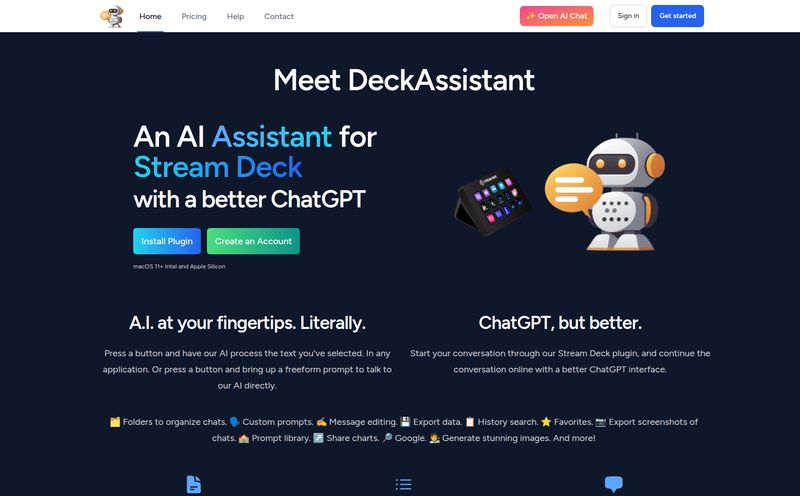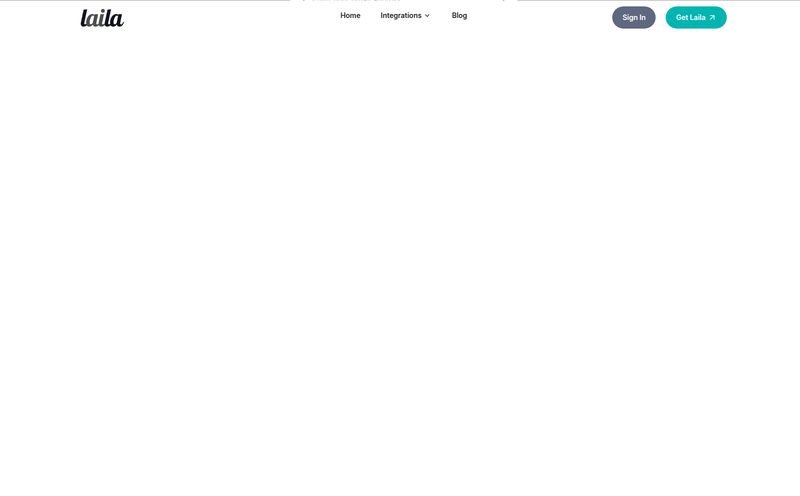I can’t tell you how many times I’ve been in a meeting, staring at a slide, and someone asks that one brilliant, killer question. You know the one. The question that cuts right to the heart of the matter. And the answer is always the same: “Great question. I’ll… uh… ask the BI team and get back to you.”
And then you wait. And wait. And by the time the report comes back a week later, the moment has passed, the momentum is gone, and everyone’s moved on to the next fire.
It's a story as old as data itself. The people with the questions aren't the people with the keys to the database. For years, we've been promised the “democratization of data,” but for most frontline teams, it has felt more like a distant dream. Well, I think that might be starting to change. I've been looking at a tool called Chatterlytics, and it's got me feeling pretty optimistic.

Visit Chatterlytics
So, What Exactly is This Chatterlytics Thing?
In the simplest terms, Chatterlytics is an AI-powered Copilot for business analytics. Think of it like this: traditional BI tools, like a Tableau or Power BI, are like being given the keys to an airplane cockpit. Incredibly powerful, yes, but you need to be a trained pilot to get any use out of it. Most of us just want to know where we're going.
Chatterlytics is more like having a personal pilot you can just talk to. You don't need to know how to write a single line of SQL or build a complex data model. You just ask your questions in plain, normal language. “Hey, what were our customer acquisition costs in Germany for Q2?” or “Show me a chart of our top-performing ad campaigns this month.” It’s designed specifically for the non-technical folks—the marketers, the sales managers, the operations leads—who are closest to the business and have the most urgent questions.
The Features That Genuinely Make a Difference
Every new SaaS tool comes with a laundry list of features, but I like to cut through the noise. Here’s what actually stood out to me about Chatterlytics.
You Can Literally Talk to Your Data
This is the main event. The AI chat interface is the core of the whole experience. The ability to just type a question and get an answer, a chart, or a table back in seconds is… well, it’s a game-changer. It lowers the barrier to curiosity. When you can get answers instantly, you start asking more questions, better questions. You start to see patterns you would have missed while waiting for that weekly report. It feels less like querying and more like having a conversation.
It Plays Nice with (Almost) Everything
One of my biggest pet peeves with new platforms is when they try to lock you into their own little world. Thankfully, Chatterlytics avoids this. It boasts support for over 20 database plugins. So whether your company's data is sitting in a classic MySQL or PostgreSQL database, or you’re working with more modern cloud warehouses, there's a good chance you can hook it up. This flexibility is critical, because no company's data infrastructure is ever as clean and simple as you’d hope.
Dashboards Without the Drama
While the ad-hoc chat is fantastic for quick insights, sometimes you need a persistent view of your key metrics. Chatterlytics lets you create and share dashboards pretty effortlessly. What I found particularly interesting is the AI-driven KPI suggestions. It can analyze your data and propose metrics you might not have thought to track. It's a neat feature that can help teams move beyond just their standard, legacy reports and discover more meaningful indicators of performance.
Your Data Stays YOUR Data
Let's talk security. In a world of constant data breach headlines, handing over access to your company’s most sensitive information is a big deal. Chatterlytics puts a heavy emphasis on its enterprise-level privacy and security. This isn't just a checkbox feature; it's a foundational requirement for any serious business tool. Knowing that it's built to handle data securely from the ground up provides some much-needed peace of mind.
My Honest Take: The Good, The Bad, and The Realistic
No tool is perfect, right? After poking around, here’s my balanced take. The biggest advantage, without a doubt, is the sheer speed and autonomy it gives to business teams. It takes the data function from being a bottleneck to being an enabler. I’ve personally seen marketing teams get bogged down for weeks trying to pull data for a campaign analysis—a task that a tool like this could potentially solve in an afternoon. It can genuinely shift a company’s culture to be more data-driven because it removes the friction.
Now for the caveats. Let's be real, this isn't a magic wand. The age-old IT principle of “garbage in, garbage out” is in full effect here. If your underlying data is a disorganized mess, Chatterlytics will just give you fast, beautifully visualized, and confidently wrong answers. Its effectiveness is completely dependent on the quality of the data you feed it. Also, there’s an initial setup process. You can’t just sign up and go. You’ll need someone with the technical know-how (and the database passwords) to get it all connected. It’s not a six-month implementation project, but it’s not a five-minute download either.
The Elephant in the Room: What's the Price Tag?
Ah, the big question. If you go looking for a pricing page on their site, you wont find one. This is pretty common for enterprise-focused B2B software, so dont be alarmed. It almost always means they operate on a custom quote basis. The final cost will likely depend on factors like the number of users, the volume of data being processed, and the specific database connections you need.
My gut feeling? Don't expect a simple, off-the-shelf $25/user/month plan. This platform seems positioned for mid-to-large size businesses that are ready to make a serious investment in their analytics capabilities. To get the real numbers, you'll have to do what we all do in this situation: book a demo.
Who Should Be Booking That Demo?
So, is Chatterlytics for you? Here’s my breakdown:
- Book the demo if: You're a department head (in marketing, sales, ops, etc.) who wishes your team could answer their own data questions without creating a ticket. Or if you're a growing company trying to instill a data-first culture without immediately hiring a massive data science division.
- Maybe skip it if: You're a hardcore data engineer or data scientist who lives and breathes complex SQL, Python, and R. This tool is designed to abstract away that complexity, which is something you probably don't want or need. It's a ready-to-drive car, not a custom engine you can strip down and rebuild yourself.
My Final Thoughts on Chatterlytics
Overall, I'm genuinely intrigued by Chatterlytics. It represents a significant step toward what many of us in the digital marketing and analytics space have been waiting for. Making data truly accessible isn't just about giving people a login to a dashboard; it’s about giving them the power to ask their own unique questions, to follow their own curiosity. Chatterlytics seems to understand this fundamental point better than most. While it's not a silver bullet for bad data hygiene, it is a powerful catalyst for teams that are ready to move faster and make smarter, data-informed decisions. It's a tool I'll definitely be keeping an eye on.
Frequently Asked Questions (FAQ)
- 1. What is Chatterlytics in simple terms?
- Chatterlytics is an AI tool that lets business users get data insights and create reports by asking questions in plain English, without needing to know how to code.
- 2. Do I need to be a technical expert to use Chatterlytics?
- Not at all. It's designed specifically for non-technical users in roles like marketing, sales, and operations. If you can write an email, you can use Chatterlytics.
- 3. What kinds of databases does it support?
- It supports over 20 different database plugins for both structured and semi-structured data, including common ones like MySQL, PostgreSQL, and others.
- 4. Is Chatterlytics secure for sensitive company data?
- Yes, it's built with enterprise-grade security and privacy features to ensure that your company's data is handled securely.
- 5. How is this different from a tool like Tableau or Power BI?
- While they all deal with data, Tableau and Power BI are complex tools that typically require specialized skills to build reports. Chatterlytics is a conversational AI copilot that allows anyone to get instant answers and visualizations by simply asking questions.
- 6. How much does Chatterlytics cost?
- Pricing is not publicly listed. It's an enterprise solution that likely requires a custom quote based on your company's specific needs. You'll need to contact them for a demo and pricing information.
References and Sources
For further reading on the concepts discussed in this article, you can check out the following resources:
- Chatterlytics Official Website (Assumed URL)
- Gartner on Data Democratization
- TechCrunch on the Rise of AI Copilots



